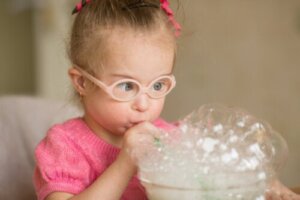10 Exercises to Improve Diction in Children


Written and verified by the teacher Samanta Ruiz
Expressing letters and words with the right sound is essential for communication. Therefore, if you notice that your child has problems with pronunciation, don’t hesitate to apply these exercises to improve diction in children.
You should keep in mind that not everyone speaks in the same way. And, as defined by the Royal Spanish Academy:
“Diction is the set of characteristics that define the way a person speaks and writes”.
So, although there are personal features in speech, there are also universal mechanisms that allow us to build words and sentences so we can communicate properly.
If your child’s diction is a problem, help them improve their diction with the activities we share below.
Improve diction in children with easy and fun exercises

1. Pencil exercise
This is one of the most famous exercises because it provides very good results and because it’s very entertaining for children.
It consists of biting a pencil horizontally with the teeth and then, reading aloud for 10 to 15 minutes. The objective is for the facial muscles and the tongue to strain in order to make a correct diction.
2. Reading practices
Reading is a great ally for language acquisition and enrichment, but also to improve diction in children.
Reading aloud a tongue twister improves children’s pronunciation; reading poetry helps them to vocalize, pause, and modulate their voice; reading in syllables allows them to distinguish sounds.
3. Speak slowly
When children are too fast to speak, they alter words and don’t pay attention to pronunciation. One way to change this is to teach them to speak more slowly.
4. Exercise the facial muscles
A good strategy to strengthen and mobilize the muscles of the face is to articulate in an exaggerated way and with the mouth open. Also, do exercises such as the following:
- Moving the jaw sideways
- Opening and closing the mouth repeatedly
- Playing with air, inflating and deflating the cheeks
5. Make movements with the lips
Exercising the lips and mouth is a lot of fun and also a beneficial way to improve diction in children. Here are some examples:
- Blowing kisses in the air
- Whistling to call the pet
- Hiding the lips (top, bottom, or both)
- Blowing and making engine noises
- Repeated smiling
6. Exercises with the tongue
The tongue is one of the organs involved in diction and defines many sounds. Some tongue exercises are the following:
- Sticking out the tongue repeatedly with the mouth open
- Touching the corner of the lips with the tongue
- Clicking the tongue
- Bending the tongue and sticking it out without touching the lips
- With the mouth closed, touching the teeth and running your tongue over them
7. Adapt the way you breathe
Controlling your breathing when you speak is essential to avoid fatigue. To do this, it’s important that you teach your child to speak slowly, not to breathe with their mouth open, and to pay attention to their breathing. Put it into practice with these simple exercises:
- Blowing bubbles with a straw
- Blowing up balloons
- Teaching diaphragmatic breathing
- Blowing whistles
8. Sing their favorite songs
When children sing, they learn to pronounce words and improve their diction. In addition, music is relaxing, helps them incorporate new vocabulary, and even learn other languages.
9. Practice everyday sounds
This can also be a fun game! Imitating the sound of a horse galloping, a cat meowing, a dog barking, or the noise of an airplane or train are great ways to exercise the muscles involved in diction.

10. Add body language
Vocalizing words with exaggeration, including gestures and body movements, helps improve diction.
What do the experts say?
According to the Spanish Association of Pediatrics, difficulty pronouncing certain sounds is a mild disorder called dyslalia and is classified in the group of speech problems. The experts of this scientific society define it as follows:
“Dyslalia is an error in the specific articulation for certain consonant sounds, it is almost always transitory”
In general, it’s a problem of motor coordination of the phonoarticular organs (lips, tongue, palate, teeth, jaw, or cheeks). These structures become accustomed to misarticulation and cause alterations in the sounds of letters and words.
If this occurs with your child, the first thing to do is to consult a medical professional to evaluate the type of disorder. If dyslalia is confirmed, these exercises to improve diction in children will be very useful to practice at home.
Expressing letters and words with the right sound is essential for communication. Therefore, if you notice that your child has problems with pronunciation, don’t hesitate to apply these exercises to improve diction in children.
You should keep in mind that not everyone speaks in the same way. And, as defined by the Royal Spanish Academy:
“Diction is the set of characteristics that define the way a person speaks and writes”.
So, although there are personal features in speech, there are also universal mechanisms that allow us to build words and sentences so we can communicate properly.
If your child’s diction is a problem, help them improve their diction with the activities we share below.
Improve diction in children with easy and fun exercises

1. Pencil exercise
This is one of the most famous exercises because it provides very good results and because it’s very entertaining for children.
It consists of biting a pencil horizontally with the teeth and then, reading aloud for 10 to 15 minutes. The objective is for the facial muscles and the tongue to strain in order to make a correct diction.
2. Reading practices
Reading is a great ally for language acquisition and enrichment, but also to improve diction in children.
Reading aloud a tongue twister improves children’s pronunciation; reading poetry helps them to vocalize, pause, and modulate their voice; reading in syllables allows them to distinguish sounds.
3. Speak slowly
When children are too fast to speak, they alter words and don’t pay attention to pronunciation. One way to change this is to teach them to speak more slowly.
4. Exercise the facial muscles
A good strategy to strengthen and mobilize the muscles of the face is to articulate in an exaggerated way and with the mouth open. Also, do exercises such as the following:
- Moving the jaw sideways
- Opening and closing the mouth repeatedly
- Playing with air, inflating and deflating the cheeks
5. Make movements with the lips
Exercising the lips and mouth is a lot of fun and also a beneficial way to improve diction in children. Here are some examples:
- Blowing kisses in the air
- Whistling to call the pet
- Hiding the lips (top, bottom, or both)
- Blowing and making engine noises
- Repeated smiling
6. Exercises with the tongue
The tongue is one of the organs involved in diction and defines many sounds. Some tongue exercises are the following:
- Sticking out the tongue repeatedly with the mouth open
- Touching the corner of the lips with the tongue
- Clicking the tongue
- Bending the tongue and sticking it out without touching the lips
- With the mouth closed, touching the teeth and running your tongue over them
7. Adapt the way you breathe
Controlling your breathing when you speak is essential to avoid fatigue. To do this, it’s important that you teach your child to speak slowly, not to breathe with their mouth open, and to pay attention to their breathing. Put it into practice with these simple exercises:
- Blowing bubbles with a straw
- Blowing up balloons
- Teaching diaphragmatic breathing
- Blowing whistles
8. Sing their favorite songs
When children sing, they learn to pronounce words and improve their diction. In addition, music is relaxing, helps them incorporate new vocabulary, and even learn other languages.
9. Practice everyday sounds
This can also be a fun game! Imitating the sound of a horse galloping, a cat meowing, a dog barking, or the noise of an airplane or train are great ways to exercise the muscles involved in diction.

10. Add body language
Vocalizing words with exaggeration, including gestures and body movements, helps improve diction.
What do the experts say?
According to the Spanish Association of Pediatrics, difficulty pronouncing certain sounds is a mild disorder called dyslalia and is classified in the group of speech problems. The experts of this scientific society define it as follows:
“Dyslalia is an error in the specific articulation for certain consonant sounds, it is almost always transitory”
In general, it’s a problem of motor coordination of the phonoarticular organs (lips, tongue, palate, teeth, jaw, or cheeks). These structures become accustomed to misarticulation and cause alterations in the sounds of letters and words.
If this occurs with your child, the first thing to do is to consult a medical professional to evaluate the type of disorder. If dyslalia is confirmed, these exercises to improve diction in children will be very useful to practice at home.
All cited sources were thoroughly reviewed by our team to ensure their quality, reliability, currency, and validity. The bibliography of this article was considered reliable and of academic or scientific accuracy.
- Educación 3.0 (2021) Ejercicios para mejorar la dislalia. Disponible en: https://www.educaciontrespuntocero.com/recursos/ejercicios-para-mejorar-la-dislalia/
- Artigas, J., Rigau, E., García-Nonell. K. (2008) Transtornos del lenguaje. Asociación Española de Pediatría. Disponible en: https://www.aeped.es/sites/default/files/documentos/24-lenguaje.pdf
- Alvarez Borrello, M. (2017) Programa de Intervención para mejorar la dislalia funcional en escolares. https://docs.bvsalud.org/biblioref/2018/09/913787/programalilacs1050.pdf
This text is provided for informational purposes only and does not replace consultation with a professional. If in doubt, consult your specialist.








